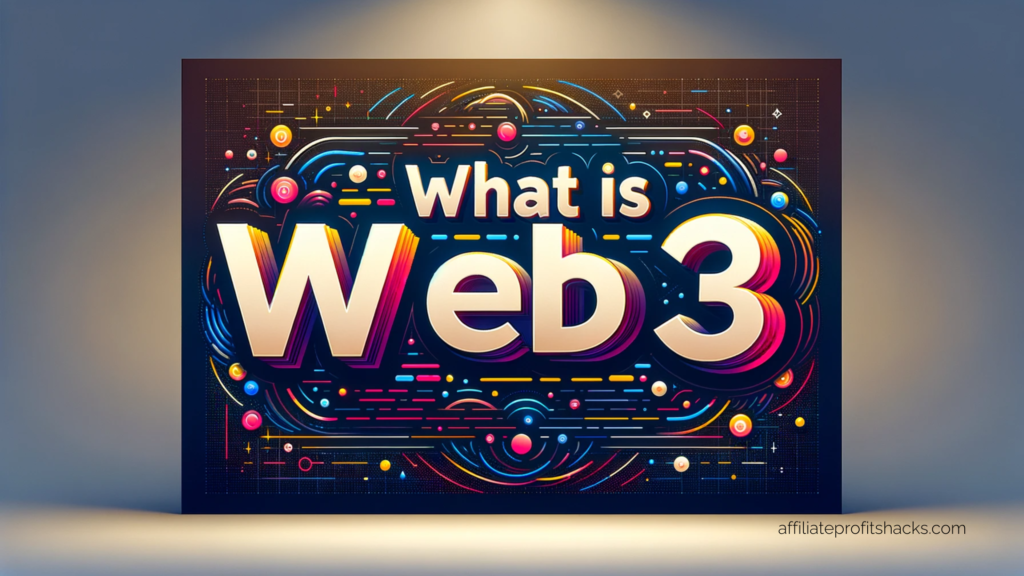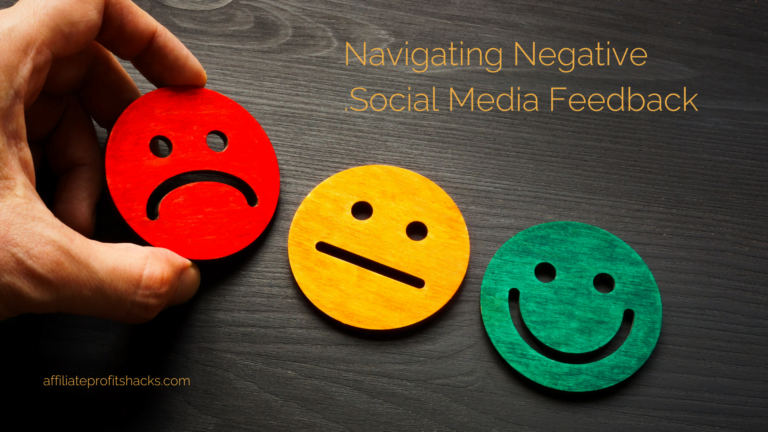What is Web3: Its Impact on Digital Marketing
Welcome and thank you for checking out my article about Web3 and its impact on digital marketing.
In recent years, a new term has started making waves in the digital world: Web3. But what exactly is Web3? At its core, Web3 represents a new paradigm in the evolution of the internet. Unlike the current version of the internet, known as Web2, which is dominated by large corporations controlling vast amounts of data, Web3 introduces a decentralized model. This model promises to return control and ownership of data back to users.
Best Recommended and Proven Way to Make Money Online – Click HERE for Instant ACCESS >>

Web3 is built on the foundational technology of blockchain, the same technology behind cryptocurrencies like Bitcoin and Ethereum. Blockchain allows for secure, transparent, and decentralized transactions. In the Web3 world, these qualities extend beyond just financial transactions to every interaction on the internet. This shift is significant because it promises a more secure, private, and user-centric online experience.
Moreover, Web3 isn’t just a theoretical concept; it’s rapidly becoming a reality. It aims to create a more democratic internet where users have a say in how platforms operate and how their personal data is used. This new version of the internet also opens up possibilities for improved digital identities, decentralized finance (DeFi), and much more.
However, as with any emerging technology, Web3 comes with its own set of challenges and controversies. Issues like technological complexity, scalability, and user adoption are at the forefront of discussions. Despite these challenges, the potential benefits of a decentralized internet make Web3 an exciting development to watch.
This article aims to demystify Web3 for the average internet user. We’ll delve into the technology behind it, explore its impact on data privacy and security, examine its real-world applications, address the challenges it faces, and provide practical tips for those interested in getting started with Web3. So, let’s embark on this journey to understand the future of the internet.
Web3 and Its Influence on Digital Marketing
As we explore the vast landscape of Web3, it’s crucial to understand its impact on various sectors, particularly in digital marketing. Web3 is not just a technological shift; it’s also a paradigm shift in how businesses can interact with consumers. Let’s delve into how Web3 is influencing digital marketing strategies.
Personalization and Data Control
Web3’s decentralized nature offers a new level of personalization in marketing while respecting user privacy. Unlike traditional online advertising, which relies on collecting vast amounts of user data often without explicit consent, Web3 enables a more transparent relationship between consumers and brands. Users have more control over their data, allowing them to choose what information they share. This shift can lead to more trust and engagement between consumers and marketers.
Tokenization and Customer Loyalty
Tokenization, a core aspect of Web3, presents innovative ways to handle customer loyalty and rewards. Brands can issue their own tokens or cryptocurrencies as part of loyalty programs. These digital tokens can offer more flexibility and value than traditional loyalty points, potentially enhancing customer engagement and retention.
Enhanced Transparency and Trust
The transparency inherent in blockchain, the underlying technology of Web3, can significantly enhance trust in marketing. For instance, advertisers can use blockchain to provide verifiable proof of ad delivery and engagement. This transparency can reduce fraud in digital advertising and lead to more efficient spending of marketing budgets.
New Avenues for Content Monetization
Web3 opens up new avenues for content monetization, which is particularly relevant for influencers and content creators in the marketing domain. With Web3, creators can have more control over their content and its monetization, thanks to technologies like NFTs (Non-Fungible Tokens). NFTs enable unique ownership of digital content, which can be a game-changer in how digital content is valued and traded.
Preparing for a Decentralized Marketing Future
As Web3 continues to evolve, marketers need to stay informed and prepared for these changes. Understanding the nuances of blockchain, NFTs, decentralized applications, and cryptocurrencies will be crucial. Additionally, adapting to a marketing landscape where consumers have more control over their data will require new strategies and approaches.
In conclusion, Web3 is set to have a profound impact on digital marketing. Its emphasis on decentralization, user data control, transparency, and new monetization methods offers exciting opportunities for marketers. As we move further into the Web3 era, adapting to and embracing these changes will be key for businesses looking to stay ahead in the digital marketing game.
Behind the Scenes of Web3: Exploring its Core Technologies
The world of Web3 is fascinating, largely because of the innovative technologies that drive it. To truly understand Web3, it’s essential to explore these technologies, primarily blockchain, and how they differ from those used in our current internet infrastructure.
Blockchain: The Backbone of Web3
Blockchain is the most crucial component of Web3. It’s a distributed ledger technology that records transactions across many computers so that the record cannot be altered retroactively. This technology, which underpins cryptocurrencies, is what makes Web3 inherently different. In Web2, data is stored in centralized servers owned by corporations, creating a single point of failure and control. Blockchain, however, distributes data across a network, ensuring no single entity has total control or access, thereby enhancing security and transparency.
Smart Contracts: Automating Transactions
Another key technology in Web3 is smart contracts. These are self-executing contracts, with the terms of the agreement between buyer and seller directly written into lines of code. They automate transactions and agreements, executing them when predefined conditions are met, without the need for intermediaries. This automation could revolutionize how we interact online, making processes more efficient and trustworthy.
Decentralized Applications (DApps): Beyond Centralized Control
Decentralized applications (DApps) are another pillar of Web3. Unlike traditional applications, which run on a single server, DApps run on a blockchain network. This decentralization means that DApps are not controlled by any single entity, offering a level of autonomy and resilience against censorship and control that is not possible in the Web2 paradigm.
Interoperability and Tokenization
Interoperability and tokenization are also significant aspects of Web3. This refers to the ability of different blockchain networks to communicate and work together seamlessly. Tokenization, on the other hand, is the process of converting rights to an asset into a digital token on a blockchain. This aspect of Web3 paves the way for new forms of digital assets and economies.
The Role of Cryptocurrencies
Lastly, cryptocurrencies are integral to Web3. They are more than just digital money; they are a means of incentivizing and facilitating the decentralized processes that Web3 is built upon. Cryptocurrencies can be used to reward users for contributing to the network, thus encouraging a more participatory and equitable internet.
Best Recommended and Proven Way to Make Money Online – Click HERE for Instant ACCESS >>
In summary, the core technologies behind Web3 – blockchain, smart contracts, DApps, interoperability, tokenization, and cryptocurrencies – collectively create a new digital environment. This environment is more secure, transparent, and user-centric. The shift from centralized control to a decentralized system promises a more democratic and equitable online experience. However, it’s important to acknowledge that these technologies are still evolving, and the journey to a fully realized Web3 is ongoing.
Securing Your Data: Web3’s Approach to Privacy and Security
In the current digital age, data privacy and security are of paramount importance. Web3 offers a new perspective on these issues, promising to enhance both through its decentralized nature. Understanding how Web3 contributes to greater privacy and security is key to appreciating its potential impact.
Decentralization: A Shield Against Data Breaches
One of the primary ways Web3 enhances security is through decentralization. In traditional Web2 systems, data is stored in centralized servers, making them lucrative targets for hackers. A single breach can compromise the data of millions of users. Web3, with its blockchain foundation, distributes data across a network of nodes. This means there’s no central point of failure, drastically reducing the risk of large-scale data breaches.
Enhanced Privacy Through User Control
Privacy is another area where Web3 shines. In Web2, users often surrender their personal data to use services, leading to concerns about how this data is used or misused. Web3 changes this dynamic by giving users control over their data. With blockchain, users can manage their data and who has access to it, fostering a more privacy-respecting internet.
Encryption: A Layer of Security
Encryption is another critical aspect of Web3’s approach to security. Blockchain technology inherently includes advanced encryption, which safeguards data from unauthorized access. This encryption is not just about making data unreadable to outsiders; it’s also about ensuring that transactions and communications are secure and tamper-proof.
The Role of Identity Management
Identity management in Web3 also differs significantly from the current internet model. Web3 introduces the concept of self-sovereign identity, where users have complete control over their digital identities. This approach contrasts sharply with the Web2 model, where digital identities are frequently tied to and managed by central authorities or platforms.
Smart Contracts: Automating Trust
The use of smart contracts also plays a vital role in enhancing security. By automating processes and transactions based on pre-set conditions, smart contracts reduce the risk of fraud and human error. This automation not only makes transactions more secure but also more efficient and transparent.
Potential Challenges and Limitations
However, it’s important to recognize the challenges and limitations of Web3 in the context of privacy and security. The technology is still in its nascent stages, and issues like key management and the complexity of blockchain systems pose potential risks. Moreover, regulatory uncertainties and the evolving nature of cyber threats continue to be significant concerns.
In conclusion, Web3’s approach to privacy and security marks a significant shift from the centralized model of the current internet. Its emphasis on decentralization, user control, encryption, self-sovereign identity, and smart contracts offers a more secure and privacy-focused online environment. While challenges remain, the advancements in Web3 technologies are paving the way for a safer and more secure digital future.
Practical Uses of Web3: Current and Future Scenarios
While Web3 is still developing, it’s not just a concept for the future; it’s already beginning to take shape in various forms. Understanding its current applications and potential future scenarios provides a clearer picture of how Web3 could transform our digital world.
Current Applications of Web3
Web3’s current applications are diverse, ranging from finance to social media. In the financial sector, decentralized finance (DeFi) platforms are perhaps the most prominent example. DeFi uses blockchain and smart contracts to create financial instruments without the need for traditional intermediaries like banks. This approach offers greater accessibility and potential returns for users.
In the realm of social media, decentralized platforms are emerging as alternatives to traditional, centralized ones. These platforms give users more control over their data and content, reducing the power of large corporations over online discourse and information.
Another growing area is the Non-Fungible Token (NFT) market. NFTs, which represent ownership of unique digital items using blockchain, have seen a surge in popularity. They’re revolutionizing how digital art and collectibles are bought, sold, and owned.
Future Potential of Web3
Looking towards the future, the potential applications of Web3 are even more exciting. One area with significant promise is the development of decentralized autonomous organizations (DAOs). DAOs use blockchain and smart contracts to create organizations without centralized leadership, potentially changing how companies and institutions are run.
The integration of Web3 with the Internet of Things (IoT) could also lead to more secure and efficient networks of interconnected devices. With blockchain, data from IoT devices could be securely shared and utilized, enhancing everything from supply chain management to smart home technology.
Another exciting prospect is the creation of truly decentralized digital identities. This development could lead to more secure and private ways of verifying identity online, without relying on centralized entities.
The Role of Artificial Intelligence
Furthermore, the integration of artificial intelligence (AI) with Web3 technologies could bring about intelligent, decentralized systems capable of making automated decisions based on real-time data. This integration has the potential to create more efficient, transparent, and fair systems in various sectors.
Challenges to Overcome
Despite these promising scenarios, there are challenges to overcome. Scalability, user adoption, and regulatory compliance are significant hurdles. As Web3 technologies evolve, addressing these challenges will be crucial in realizing their full potential.
In conclusion, the practical uses and future potential of Web3 are vast and varied. From revolutionizing finance and social media to paving the way for innovative organizational structures and secure digital identities, Web3 is set to change the digital landscape profoundly. While there are hurdles to overcome, the ongoing developments in this space indicate a bright and transformative future for Web3 technologies.
Debating Web3: Addressing the Challenges and Concerns
While Web3 offers numerous opportunities, it’s not without its challenges and controversies. Addressing these issues is essential to understand the full spectrum of Web3 and its implications for the future of the internet.
Best Recommended and Proven Way to Make Money Online – Click HERE for Instant ACCESS >>
Technological Complexity and User Experience
One of the significant challenges facing Web3 is its technological complexity. The concepts behind blockchain, smart contracts, and decentralized applications can be difficult to grasp for the average user. This complexity not only impacts user adoption but also the development of user-friendly interfaces. Simplifying these technologies for broader use without compromising their core principles is a key challenge for Web3 developers.
Scalability and Performance Issues
Scalability is another major concern. Blockchain networks, in their current form, often struggle with handling large volumes of transactions quickly and efficiently. This limitation poses a significant hurdle for the widespread adoption of Web3, particularly in applications requiring high transaction throughput, like online payments or gaming.
Regulatory and Legal Hurdles
The regulatory landscape for Web3 is still evolving. Laws and regulations lag behind the rapid development of blockchain and cryptocurrency technologies. This uncertain regulatory environment poses challenges for businesses and users who are keen to explore Web3 but are cautious about potential legal implications.
Environmental Impact
The environmental impact of some blockchain networks, especially those relying on energy-intensive proof-of-work mechanisms, is a growing concern. As awareness of climate change and sustainability grows, the high-energy consumption of these networks has come under scrutiny. Developing more energy-efficient consensus mechanisms is crucial for the sustainable growth of Web3.
Security and Privacy Paradoxes
Despite its promise of enhanced security and privacy, Web3 is not immune to risks. The decentralized nature of blockchain can make it difficult to address illegal activities and enforce regulations. Additionally, the permanence of blockchain records raises privacy concerns, especially in scenarios where data rectification or deletion is required.
Bridging the Adoption Gap
Finally, bridging the gap between the early adopters of Web3 and the general public is a significant challenge. For Web3 to realize its full potential, it must be accessible and beneficial to a broad audience, not just technology enthusiasts and early adopters.
In summary, while Web3 holds great promise for a more decentralized, secure, and user-empowered internet, it faces several challenges. These include technological complexity, scalability issues, regulatory uncertainties, environmental concerns, security and privacy paradoxes, and the need for wider adoption. Addressing these challenges will be crucial in shaping the future of Web3 and ensuring its successful integration into the fabric of our digital lives.
Conclusion: Embracing the Web3 Era
As we conclude our exploration of Web3 and its multifaceted impact, it’s clear that we’re standing at the cusp of a significant digital evolution. Web3 promises a future where the internet becomes more decentralized, secure, and user-centric. From transforming how we handle data privacy and security to reshaping digital marketing, Web3 is paving the way for profound changes in our online experiences.
The journey into Web3, however, is not without its challenges. As we’ve seen, technological complexities, scalability issues, and regulatory uncertainties are hurdles that require careful navigation. Moreover, the shift from a centralized to a decentralized web requires not just technological adjustments but also a change in mindset for businesses, developers, and users alike.
Despite these challenges, the potential of Web3 to create a more equitable, transparent, and efficient internet is undeniable. As we gradually embrace this new era, staying informed, adaptable, and open to learning will be crucial. For businesses, integrating Web3 technologies like blockchain, smart contracts, and decentralized applications into their operations can open up new opportunities for innovation and growth. For individuals, understanding and leveraging the benefits of Web3 can lead to greater control over their digital identities and data.
Best Recommended and Proven Way to Make Money Online – Click HERE for Instant ACCESS >>
Web3 is not just a new technology; it’s a new chapter in the digital age, promising to redefine our interactions with the online world. As we move forward, the possibilities are limitless. Whether you are a technology enthusiast, a digital marketer, a business owner, or just a curious individual, the time to explore and adapt to Web3 now. The future of the internet is unfolding, and it holds exciting prospects for everyone.
The in-depth links in this Wikipedia article show the amount of research that is being done.
Thank you for taking the time to read my article “What is Web3: Its Impact on Digital Marketing”. I hope that you found value in it!
You might be interested in this related article about XRP and its Role in Next-Generation Banking.







